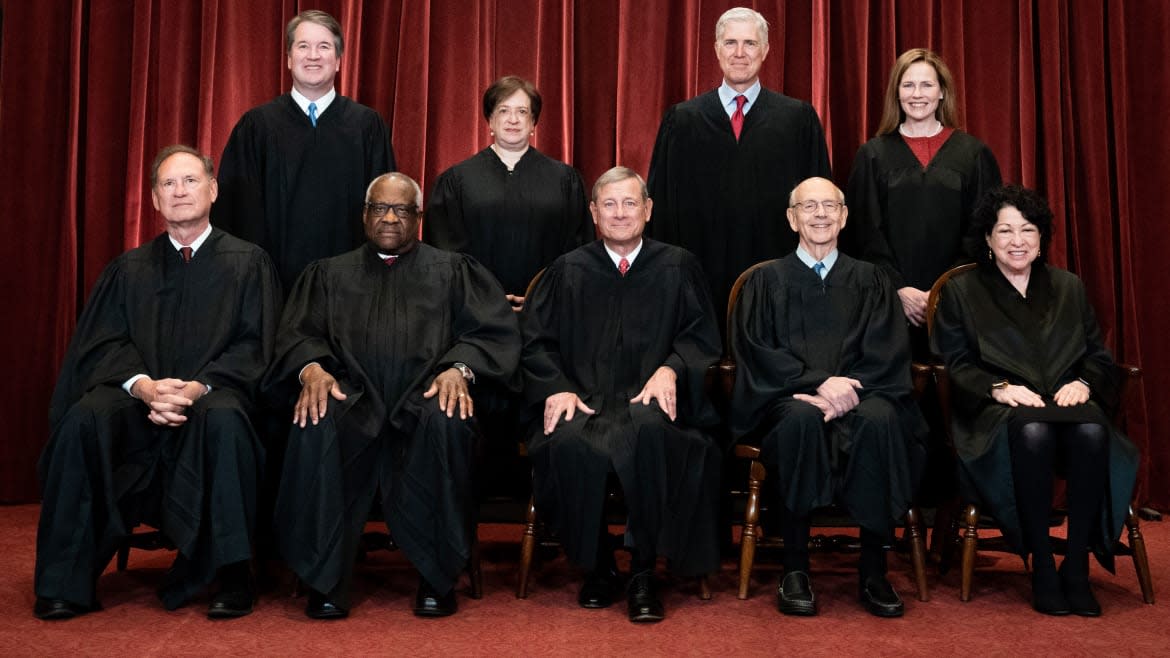How the Supreme Court Flunked a Math Test on Gerrymandering

On Thursday August 12, the Census bureau released the final redistricting data from the 2020 census. What that count tells us about the current size and distribution of the American population has already been skewed by the political manipulation of Wilbur Ross, Steve Bannon, and others, but the new data about the changing density of population and its racial and ethnic makeup across neighborhoods is providing the information that will drive a whole new wave of gerrymandering across the country.
Gerrymandering is, by definition, unfair, but in 2019 everyone on the Supreme Court save Elena Kagan ignored the math that proves exactly how we know when redistricting is drawn for partisan gain. It’s impossible to tell whether this cross-party dereliction of duty was due to negligence, incompetence, or political opportunism, but, coming as it did at the start of a period of Republican anti-voter fervor, the Court’s decision in Rucho v. Common Cause effectively put the first nail in the coffin of voters’ rights.
At stake in the decision was the ability of the Supreme Court to intervene in partisan redistricting cases. The justices also considered Rucho v. League of Women Voters of North Carolina, and Lamone v. Benisek, nominally balancing the parties, given that the Rucho cases concerned Republican gerrymandering in North Carolina and Lamone concerned Democrat gerrymandering in Maryland. Kagan wrote in the dissent that the cases concerned the “foundations” of America’s democracy, and that the unfair redrawing of districts in “these cases imperil our system of government.”
The 5-4 decision divided strictly along partisan lines. The majority opinion, written by Chief Justice John Roberts, ruled that gerrymandering was “nonjusticiable”—which is to say, beyond the scope of the court. In his new book, Shape: The Hidden Geometry of Information, Biology, Strategy, Democracy and Everything Else, Jordan Ellenberg shows how wrong that is.
Democrats Hate Gerrymandering—Except When They Get to Do It
Popular democracy means making arguments that are simple, clear, and appealing enough to win people’s votes. Unfortunately, at any stage the process of making sure that these votes count in an equitable manner can be complex. And, even when it’s explained clearly by experts like Ellenberg, the process can be willfully obscured by those who don’t want to put their faith in public opinion.
That’s true about voter rights and restrictions, it’s true about the electoral college, it’s true about census taking, and it’s true about the redrawing of electoral districts as populations shift. In many of those cases there isn’t an analytical method of assessing fairness or the balance of priorities, but in the case of redistricting, there is. In his final chapter, this analysis is scrupulously explained by Ellenberg—New York Times best-selling author of How Not To Be Wrong and co-signatory of the unprecedented “Amicus Brief Of Mathematicians, Law Professors, And Students” to the Supreme Court in the case of Rucho v. Common Cause.
In the novella-length chapter “How Math Broke Democracy (and Might Still Save It),” Ellenberg explains the geometry behind gerrymandering. Although he draws on the lessons of the preceding 340 pages and takes 70 pages to complete his analysis, the principle is simple. Geometry allows us to compare shapes and their characteristics with one another—a lot of shapes and characteristics. That means we can compile a graph that plots every possible district redraw against how they would elect representatives given the existing voting system. Once we have such a graph, it’s easy to put an X on that graph for any new proposal and see how far it is from the norm.

The thrust of Ellenberg’s argument is descriptive not prescriptive. He’s not suggesting how to draw a district, he’s showing exactly how one would describe the fairness of a system without any recourse to the red herring of proportional representation that the conservative justices kept raising. And he shows mathematically how the Supreme Court was plumb wrong to find that there was no “limited and precise standard” for evaluating partisan gerrymandering.
Although gerrymandering requires redrawing shapes on a map, the real input of geometry is in measuring the fairness of the maps. Mathematicians, in his opinion, should not legislate politics or ethics. Geometers, however, can describe the exact fairness of a particular redistricting. Math can calculate the representation provided by every single map that could be drawn and can thus show that, for example, the proposed Wisconsin redistricting maps drawn up in secret by Republicans after the 2010 census are wide outliers on that distribution.
Ellenberg is the John D. MacArthur Professor of Mathematics at the University of Wisconsin-Madison and Wisconsin is close to his heart. He tells us how, in an “ensemble of Wisconsin assembly maps,” the mathematician Jonathan Mattingley testified that such a lop-sided map occurred in only 162 of the 24,518 cases. In other words, to go with the clear, documented proof that the Republicans in this case attempted to gerrymander, the math proves they succeeded and provides exactly that general standard of fairness that Chief Justice John Roberts claimed he was looking for in the Rucho and Lamone cases and then willfully ignored.
In general, Roberts gets an F from Professor Ellenberg. Ellenberg likens the Chief Justice’s actions to walking out while the building is on fire and not using the fire extinguisher to hand. Roberts disingenuously excuses the Supreme Court from taking action against gerrymandering that even the majority says “reasonably seem unjust” and are, “incompatible with democratic principles.”
“There’s a fire extinguisher right there on the wall—he could grab it and spray foam all over the problem, but… there’s a principle at stake here… If he puts out this fire, he sets a precedent; now is he on the hook every time the building catches fire after the whistle blows?”
The building of U.S. political representation is about to catch fire and, with the Supreme Court having made its feelings clear, Ellenberg is not placing false hope in the legal system. But, despite our political situation, he is an avowed optimist and believes that with “mathematical thinking” and a “well-lighted classroom” the fire of gerrymandering can be doused.
This final chapter is by far the most compelling in Shape. It delivers on the book’s recurrent insight, which is the power of the “theory of the random walk” (also known, in non-PC terms, as the “Drunkard’s Walk”). Roughly speaking, by counting enough small changes and analyzing them, you can both build up a picture of real-world probabilities and develop algorithms to exploit them.
The idea is introduced as Sir Ronald Ross’ mosquito problem: How do we know where a mosquito will be at a given point in time? Well, if we know where it was at the previous moment, there are a limited number of places it could be now and, as we move on through time, we can measure its probable location at any point. The principle works for mosquitoes, for molecules, for company stocks, and for many other fields of endeavor, including redistricting.
Ellenberg begins with Abraham Lincoln, who was deeply engaged, maybe even obsessed, with Euclid, the Greek father of geometry. This serves two purposes:, it helps him show how non-mathematicians approach and appreciate geometry and the tight proofs it can provide that work in Euclidean geometry. Second, it gives him a way to talk about the importance of geometry to democracy. In an era where our leading politicians get away with misinformation and plain lies, the clean proofs of geometry are a useful, even vital, tool to sort the signal from the noise, the meaningful from the distracting, and truth from just truthiness.
As well as explaining mathematical mappings of reality, Ellenberg fleshes out a whole host of crazy characters. Chief among this plentiful cast are the aforementioned egotistical, irascible Ross, the British Jewish mathematician James Joseph Sylvester, and the novelist, folklorist, and applied mathematician Karl Pearson. At a time of anti-European fervor, Columbia University trustees stressed that Sylvester’s Englishness was not why they rejected him, as “they were in no way prejudiced against foreign professors, and would have found an American Jew just as unsuitable for hire.” Pearson was a Germanophile who invented the English word “sibling” to emulate the gender neutral “Geschwister” from German and kept the K of Karl when the University of Heidelberg misspelled “Carl” in some paperwork.
Although it’s not quite as plain sailing as How Not to Be Wrong, Ellenberg’s chatty style, mathematical insights, and belief in democracy are still worth the price of admission. He begins by describing redistricting as a battle between the Oranges and the Purples in the “great state of Crayola” and ends with a bitterly frustrated rewriting of the Supreme Court’s refusal to engage with the problem at hand as a dialogue about tuna melts (you have to read the chapter to get it). While demonstrating networks, he explains the math (and history) behind Six Degrees of Kevin Bacon (work out your own Erdős-Bacon number!). He forces you to reconsider how many holes there are in your pants (or bagels), and there is a party in the footnotes with erudition, witty asides, and life-warnings aplenty.
Ellenberg’s commitment to explanation, his exploration of the humanity of mathematics, and the tour de force of the final chapter in defense of a democracy girded by fairness and science are enough to remind you why he is America’s favorite math professor. This is harder work than the 101 level, but you won’t be sorry you came for the lecture.
Get our top stories in your inbox every day. Sign up now!
Daily Beast Membership: Beast Inside goes deeper on the stories that matter to you. Learn more.

